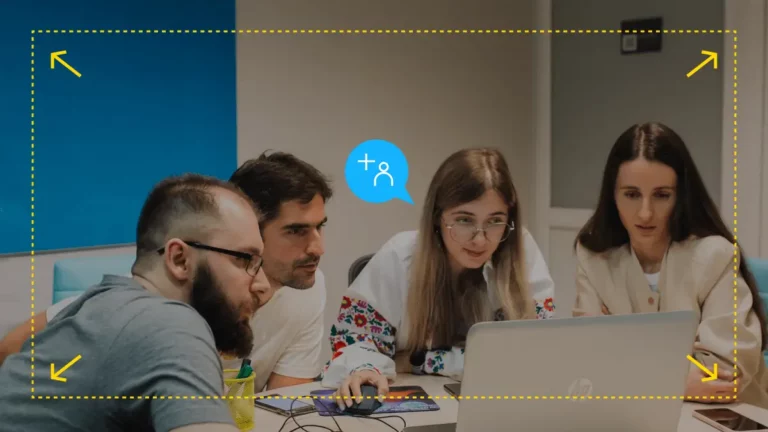Pros and Cons of Geographically Distributed Agile Teams

- Global Trends of Running Agile Distributed Teams
- Why Do Companies Build Distributed Engineering Teams?
- Top 10 Pros of Running an Agile Software Development with Distributed Teams
- Top 5 Disadvantages of Distributed Agile Teams
- How to Remain Efficient While Tailoring Agile for Distributed Teams?
- Manage Agile Distributed Teams with Mobilunity
Running remote teams these days is not a discovery neither for tech giants nor startups. Typically, the decision for finding a distributed software engineer overseas is explained by a scarcity of domestic developers, crucial need to invade new markets and save on labor costs. Not only companies succeed in creating a top-notch collaboration with their remote employees but they also competently follow Agile methodology principles. The following article will shed some light on the aspects of managing a virtual development team.
Global Trends of Running Agile Distributed Teams
Based on the 2019 Global Employee Survey, 85% of companies that run virtual teams claimed that they are likely to recommend this practice for their counterparts. The research also revealed the following: only 9% of remote team users face miscommunication or cultural difference gap problems. Other companies said the pitfalls arise from time to time depending on the internal circumstances or mismanagement. Overall, most clients say that their remote employees feel less stressed and undermotivated; on the contrary, they are more dedicated, engaged, and collaborative with both the clients and their in-house teams.
In 2018, the Annual Developer Survey identified that Agile methodologies are used by 85% of developers worldwide. They claimed that most of their clients receive quality services in a timely manner due to well-established principles required by Agile methodology. Companies pave the way to a successful collaboration with remote teams by implementing numerous tools for communication, progress tracking, and organize visits to get to know the team better and discover their needs. Knowing the statistics of world tendency for hiring distributed software teams, let’s see why companies prefer them over in-house employees, and what are the pros and cons of delegating projects overseas.
Why Do Companies Build Distributed Engineering Teams?
Traditional employment is about tying the employees to regular working hours, following office rules, and daily routine, while remote employees get more flexibility at the same time operating in a comfortable environment. Companies that decide to outsource their development or use nearshoring services should understand one thing: nothing can be set up without proper management. But what is the reason that drives organizations to run geographically distributed teams?
Access to New Markets
Whether being a well-established corporation, with high traction and a competitive position on the domestic market, or a startup, an emerging need to go further is essential. Hiring distributed teams not only allows them to extend their current staff and save costs but also promote their products and services overseas, establish new partnerships, and gain global recognition.
Rich Talent Pool
Despite the fact that the Information and Communication Technology sector is the driving source of income in many economies, the problem with IT specialists scarcity remains unresolved in many countries. Estonian IT pool accounts for about 37,000 specialists, while the Ukrainian market offers 190,000 software professionals. That is why Estonian organizations can find the required candidates much faster in Ukraine, that country will also guarantee the world-class quality of software development services.
Relocation of Subsidiary Projects
Corporations that simultaneously hold numerous projects are likely to hire remote teams to complete their small (short-term) projects in order to focus on core operations. This enables them to save costs, properly fulfill internal processes, at the same time scaling Agile with distributed teams.
Saving Costs
One of the common reasons for companies to outsource or nearshore their distributed teams is the labor costs that are offered by vendors. For instance, on average, the US IT firm spends around $104,000 annually for a full-time software developer, while the virtual development team hired from Ukraine will cost twice less.
After we defined the reasons to go for geographically distributed teams, now let’s find out the pros and cons of distributed Agile teams.
Listen to a Scrum Master working on a Swiss project how to plan sprints right & hire a dedicated Scrum Master for your team with Mobilunity
Contact usTop 10 Pros of Running an Agile Software Development with Distributed Teams
A Large Pool of Talents with Prolific Expertise
Let’s imagine that the idea of your project requires employees with a solid MS Dynamics experience. After analyzing the local market, you discovered that the number of available candidates is not satisfactory to meet your needs. In this case, distributed computing engineers of this specialization can be easily found in the Eastern European market, in countries such as Poland, Ukraine, or Romania.
Focus on the Core Operations
Usually, companies that hire remote teams, delegate secondary projects to concentrate their effort on the in-house operations with higher priority. With this in mind, they transfer small or short-term projects to the remote employees that help them considerably increase the productivity within the in-house performance.
Cultural Diversity
By hiring a team from Ukraine, you enable your business to integrate with the local culture, understand their ethics, business views, and other peculiarities that will come in handy while promoting your business in the country. Cultural difference is often mistakenly taken as the pitfall, but it can drive your innovation, provide you more insights into the local culture, and bring new knowledge in the business world.
Mitigating Risks
Small businesses or projects especially benefit from using dedicated development teams since it allows them to mitigate risks. Global pandemic has shown that having a team that is experienced in working remotely can very much ease operations and lower the negative impact.
Cost-Saving Benefits
If you operate in the US or EU market, you are probably aware that most employers spend millions of dollars to cover developers’ paychecks. Going offshore to Eastern Europe costs them half or even less for the quality services of European specialists. Another aspect where you can decrease expenses is the recruitment – the vendor’s recruiters do the research, conduct the interviews, while you assess candidates’ technical skills and select the ones. Therefore, you do not have to hire employees to create a Human Resources department, thus no additional costs are added.
Increased Efficiency
The software development project takes a huge team of developers, managers, consultants, Quality Assurance specialists, and other related employees. Moreover, it can take up to years of development before the product is released. Having distributed teams allows companies to run several projects simultaneously so that the product is delivered even ahead of the planned time.
Scale Up or Down Is Easy
Nearshoring allows you to scale up the staff with ease per your request. Let’s imagine that your startup or project initially required 2-3 developers, but some tasks needed more people to fulfill the method of the scrum. Distributed teams can be expanded by providing you additional talent in 2-4 weeks. Flexible contract length allows scale down the team in a speedy manner as well.
Top-Notch Recruitment Services
One of the key benefits of distributed Agile teams is that hiring is not your responsibility. Have you ever noticed how much time does it take for your recruiters to find, select, and interview the candidates? 2-3 months? More? The process of hiring employees by the vendor takes about 4-6 weeks since besides scanning the market, they usually have a bench of developers that allow them to find suitable developers for you in a timely manner. Even though there might be no available specialists in the providers’ team, you will receive a shortlist of candidates shortly after request. By the way, search for candidates is complimentary with Mobilunity – you get depersonalized resumes that match your requirements if for whatever reason you don’t like them, you don’t pay anything.
Competitive Advantage
Along with hiring a more skilled and experienced workforce in other countries, you may enhance your position on the domestic market by presenting more cutting-edge technology, proactiveness, and quality products acquired from overseas specialists.
Knowledge-Exchange
As your in-house team may have a need to cooperate with the remote one, they can share the knowledge in the specific area to contribute to the project’s development. Moreover, if you find your distributed employees highly-skilled, they can mentor and train your collocated employees for the benefit of the internal company’s processes.
Top 5 Disadvantages of Distributed Agile Teams
Cultural Differences
Even when nearshoring, companies still may face cultural differences which may result in misunderstandings, challenges in solving the problems, and communication. Cultural differences in distributed Agile teams are often neglected to manage properly. However, the more the client is aware of the cultural peculiarities of their remote team, the more chances they have for establishing prosperous collaboration.
Management Issues
Nearshoring presupposes the client to establish a well-organized strategy towards controlling the remote team. In order to gain a solid understanding and collaboration, companies should apply numerous approaches to make sure the team is engaged, devoted, and productive otherwise this disadvantage of having distributed Agile teams might lead to failure.
Quality Issues
This disadvantage refers to both models of hiring remote teams. When you choose to outsource, your distributed team conducts all performance in a private mode – you are not able to control the stages of developers until its completion. If you choose nearshoring, you need to have a rich technical background as you have full control over the project’s operations while dealing with distributed teams in Agile.
Time Difference or Long Distance
For some clients, even a 2 hours difference in time can be a considerable issue in enacting the team’s involvement and collaboration. But managing distributed teams using Agile methodologies gives you a competitive advantage since Agile software engineers maintain the principles of Agile methodology throughout project development.
Hidden Costs
Outsourcing is established via the contract which is signed before the project starts. However, as we covered in the previous sections, during the project development, some additional costs might be involved. When the project is finished, you may receive information on the expenses that a vendor had to incur.
How to Remain Efficient While Tailoring Agile for Distributed Teams?
All in all, distributed teams may bring you to a new level of business success: accessing the world’s best tech talents, optimizing costs, and mitigating a lot of risks. Distributed teams require more attention in terms of establishing communication, quality control, and personal approaches. Many companies also claim that the efficiency of distributed teams depends on the chosen vendor and personal involvement in teams’ management. Relocated teams possess an immense level of responsibility and dedication; most of them are less affected by a lack of motivation or professional burnout.
Geographically distributed Scrum teams provide a dynamic collaboration as they operate on small short-term tasks, thus can be managed more effectively. Clients use a variety of communication ways and visit their teams personally, thus guaranteeing a constant connection. Also, they find it useful to maintain the efficiency of remote teams by integrating them into the in-house operations to make sure everyone is working on the common goal and achieves the company’s mission. Retention is one of our primary responsibilities:

Manage Agile Distributed Teams with Mobilunity
The challenges with distributed teams working Agile can be easily mitigated if you apply smart management to your remote employees: corporate culture, constant reporting and feedback, proper task distribution, and overall team’s involvement. Distributed teams are widely hired by companies across the globe, here are some examples:
Mobilunity is actively attracting clients from Western Europe, Asia, and America. One of our biggest clients, esurance, a Swiss-based insurtech startup is successfully collaborating with a good number of 16 Ukrainian developers. The company’s representatives claim that the specialists not only demonstrated solid technical expertise but also good communication skills and the ability to integrate the overall project’s processes. Two other clients, from the UK and Japan, said that the remote development team using Agile is easy to collaborate with and are able to resolve the issues once those occur. Moreover, they managed to follow the Agile methodology, proving their efficiency and dedication.



















